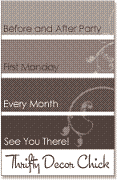BE SURE TO CHECK OUT ALL THREE NEW LINKY PARTIES HERE AT THE COTTAGE!
It's Monday night–a time to get those tough, challenging, oft-frustrating DIY questions answered by an expert.
If you've ever gotten stumped by a project and wished you had a go-to-guy for answers, this event is for you!
The details for linking up are listed below.
But first, let's address a question from last week.
Leslie @ goodbye, house! HELLO HOME! asked:
"I have a question--how do I measure my master bathroom for tile? I have no clue how much to get. What equipment would be the easiest equipment for me (tile cutter, carpet remover-yes, there is carpet in our bath--yuck, molding remover, etc...) to install this all myself?"
There is more involved in laying tile in a bathroom than most people think. So I'm going to address the issues that are most critical to a project well done.
To make the job easier, I suggest removing the bathroom and linen closet doors, the toilet, and all base trim before starting the job. Be sure to stuff a rag tightly in the hole in the floor where the toilet was removed.
My main concern for Leslie's project is whether there may be water damage under the carpet in the bathroom.
I say this because, very often, water will accumulate on the floor after shower and tub use. This moisture could seep through the carpet and into the underlayment–the flooring below the carpet. Left unchecked, this would eventually rot the flooring, and the floor joists themselves, leading to some rather expensive repairs.
It is best to examine the area around a tub or shower for signs of moisture damage, before you proceed with laying tile. This is best done by pulling the carpet away from the areas where moisture could have accumulated.
If it appears that you have some damage, then it would be in your best interest to actually go under the house–where feasible–for a closer inspection. It would also be a good idea to inspect the area around your water closet (toilet).
Any damage would need to be repaired before you could proceed.
If the home is built on a slab, then none of the above would be of any concern.
There are a few tools you'll need to perform a tile job. Most can be rented by the day for a nominal fee.
After removing doors, and the toilet, you'll need to remove all base trim from the perimeter of the room, around the vanity, closets, etc. This will be accomplished most easily with a flat bar and a hammer.
Most people own a hammer and maybe even a flatbar. If so, the base trim can be removed fairly easily. After all the trim is removed, it's best to check to be sure that you've also removed any nails that may not have come off with the trim itself.
Now, on to the carpet. Hopefully, the carpet was installed with carpet tack strips. This will make the whole process of removal much easier. However, if the carpet has been glued, then there's some work to do.
If you're unable to completely remove the glue, you may have to install 1/4" luan–an inexpensive alternative to plywood–over the work area to provide a flat work surface. There is a very important reason for this. If the material you are laying the tile on is not totally flat, you run the risk of tiles breaking in the future.
Once the carpet has been removed, re-examine the areas around the tub and toilet. If these areas are structurally sound–no rot from water damage–you can proceed.
The area where you will be applying the tile should be clean and flat. And you'll want to check for any nails that may be popping through. I like to install 3" screws approximately every foot along the joists to prevent any tiles from cracking in the future due to nail pops.
Assuming everything is in order, at this point, you will be able to install the tile right over the plywood, or concrete, with no additional preparation.
Be sure to tell whomever you purchase your tile from what you will be bonding to, i.e. wood, concrete, etc. This will determine the type of adhesive to use.
To calculate how much tile you will need is relatively easy. If your bathroom is like many, then you probably have a main area and several smaller "nooks". You want to break these areas down into separate squares or rectangles, and simply add the square footage of each section together?
Note the example above.
Once you have the square footage, the person at the home improvement store should be able to tell you how much tile to purchase–determined by the size of the tile you choose.
To prepare the tile for installation, you will need a tile cutter, and some nippers, pictured above–for cutting and trimming. The other tool you'll need is a notched trowel. This trowel can be purchased from the tile section of the hardware store.
It is extremely important to match the notch size of your trowel to the size of tile that you will be using.
If the notches are too small, then the trowel will not deposit enough adhesive and your tile will not adhere. If the notches are too large, then you could deposit too much adhesive and find it oozing out onto your tiles–creating a real mess.
Something else to take into consideration is your toilet. It will be raised off the floor the thickness of the tile you choose. To remedy this, you will need to purchase a new wax ring with an extended flange, before resetting it.
Be sure to tile the area under the toilet to within 1" of the retaining ring in the floor. These tiles don't need to be pretty on the end that's going under the toilet. Rough cuts will work just fine, as long as they can't be seen after the toilet is in place.
You'll also want to cut the bottom of the all door trim to accommodate the tiles–if the space is not high enough for the tile to slide under.
As you can see, there is much involved in tiling a bathroom, and because I think anyone without experience would benefit from actually seeing it done–as in a video–I've limited my response to potential problem areas.
You could mostly likely find some great step-by-step how-to videos at your local library or Online.
Now, it's your turn to Ask the Yankee!
Here's how:
Create a post on your blog addressing your DIY question and showing others where you're stuck in your project and need direction.
Link your post to the Ask the Yankee event with a direct link–not one to your main blog and
link back to the Brambleberry Cottage.
Or...
Leave your question in the comment section of this Ask the Yankee post, and place the event button on your blog's sidebar.
Next week, a question or two–along with their solutions–will be featured at the cottage.













































































































hey girl...would you mind popping in and letting me know if my post that I am putting up for Tuesday qualifies for your linky party??? I'd hate to be there if it's not appropriate!!!
ReplyDeleteOH WOW!!!
ReplyDeleteI thank you thank you thank you for the answer!
I think I could probably do this with some help from my family and a few friends!
We do actually have a small area around the tub and shower and toilet that is vinyl-ed.
So, I am not expecting to find any rot (I pray).
I cannot believe you are so wonderful to answer my question in such detail!
Thank you to your wife, also that let me borrow your brain!
Much gratefulness,
Leslie
P.S. I promise to show you what I did when it's finished!
It may be a few months down the road, though, as I like bargains, and the tile/other stuff I find will have to be bargains.